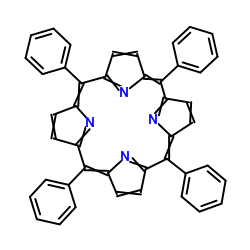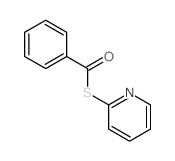14640-21-2
| Name | magnesium tetraphenylporphyrin |
|---|---|
| Synonyms |
MFCD00049815
Magnesium,[5,10,15,20-tetraphenyl-21H,23H-porphinato(2-)-N21,N22,N23,N24]-(SP-4-1) MAGNESIUM MESO-TETRAPHENYLPORPHYRIN 5,10,15,20-Tetraphenyl-21H,23H-porphine Magnesium(II) Magnesium(II) meso-Tetraphenylporphine 5,10,15,20-tetraphenyl-21H,23H-porphine,magnesium complex (1:1) Magnesium meso-Tetraphenylporphine n-hydrate magnesium tetraphenylporphine MAGNESIUM MESO-TETRAPHENYLPORPHINE (5,10,15,20-tetraphenyl-porphinato(2-)-N21,N22,N23,N24)-magnesium Magnesium TPP (meso-tetraphenylporphyrinato)magnesium(II) Magnesium meso-te |
| Description | Magnesium meso-tetraphenylporphine is a biochemical reagent that can be used as a biological material or organic compound for life science related research. |
|---|---|
| Related Catalog |
| Molecular Formula | C44H28MgN4 |
|---|---|
| Molecular Weight | 637.02500 |
| Exact Mass | 636.21600 |
| PSA | 34.58000 |
| LogP | 7.15260 |
|
Section 1: Product Identification Chemical Name:Magnesium meso-tetraphenylporphine hydrate CAS Registry Number:14640-21-2 Formula:(C44H28N4)Mg.XH2O EINECS Number:none Chemical Family:metal porphine (porphyrin) complex Synonym:none
Section 2: Composition and Information on Ingredients IngredientCAS NumberPercentACGIH (TWA)OSHA (PEL) Title Compound14640-21-2100%no datano data Section 3: Hazards Identification Emergency Overview:No particular hazard associated with this material. Primary Routes of Exposure:Ingestion Eye Contact:May cause slight to mild irritation of the eyes Skin Contact:May cause slight to mild irritation of the skin. Inhalation:Dust may be irritating to the nose, mucous membranes and respiratory tract. Ingestion:No specific information is available on the physiological effects of ingestion. Acute Health Affects:May be irritating to skin, eyes and respiratory tract. Chronic Health Affects:No information available on long-term chronic effects. NTP:No IARC:No OSHA:No SECTION 4: First Aid Measures Immediately flush the eyes with copious amounts of water for at least 10-15 minutes. A victim may need Eye Exposure: assistance in keeping their eye lids open. Get immediate medical attention. Wash the affected area with water. Remove contaminated clothes if necessary. Seek medical assistance if Skin Exposure: irritation persists. Remove the victim to fresh air. Closely monitor the victim for signs of respiratory problems, such as difficulty Inhalation: in breathing, coughing, wheezing, or pain. In such cases seek immediate medical assistance. Seek medical attention immediately. Keep the victim calm. Give the victim water (only if conscious). Induce Ingestion: vomiting only if directed by medical personnel. SECTION 5: Fire Fighting Measures Flash Point:no data Autoignition Temperature:none Explosion Limits:none Extinguishing Medium:dry chemical, carbon dioxide, or foam. If this product is involved in a fire, fire fighters should be equipped with a NIOSH approved positive pressure Special Fire Fighting Procedures: self-contained breathing apparatus and full protective clothing. Hazardous Combustion andIf involved in a fire this material may emit toxic organic fumes. Decomposion Products: Unusual Fire or Explosion Hazards: No unusual fire or explosion hazards. SECTION 6: Accidental Release Measures Small spills can be mixed with vermiculite, sodium carbonate or other suitable non combustible adsorbent and Spill and Leak Procedures: swept up. SECTION 7: Handling and Storage Handling and Storage:Store the material in a tightly sealed container in a cool, dry place. SECTION 8: Exposure Controls and Personal Protection Eye Protection:Always wear approved safety glasses when handling a chemical substance in the laboratory. Skin Protection:Wear appropriate chemical resistant gloves and clothing. Ventilation:Material may form a fine dust. If possible, handle the material in an efficient fume hood. Respirator:No respirator is required when handling this material. Ventilation:Material may form a fine dust. If possible, handle the material in an efficient fume hood. Additional Protection:No additional protection required. SECTION 9: Physical and Chemical Properties Color and Form:purple xtl. Molecular Weight:637.04 Melting Point:no data Boiling Point:no data Vapor Pressure:no data Specific Gravity:no data Odor:none Solubility in Water:insoluble SECTION 10: Stability and Reactivity Stability:air and moisture stable Hazardous Polymerization:no hazardous polymerization Conditions to Avoid:none Incompatibility:none Decomposition Products:carbon dioxide, carbon monoxide, magnesium oxide, nitrogen oxides, and organic fumes SECTION 11: Toxicological Information RTECS Data:No information available in the RTECS files. Carcinogenic Effects:No data available Mutagenic Effects:No data available Tetratogenic Effects:No data available SECTION 12: Ecological Information Ecological Information:No information available SECTION 13: Disposal Considerations Disposal:Dispose of according to local, state and federal regulations. SECTION 14: Transportation Shipping Name (CFR):Non-hazardous Hazard Class (CFR):NA Additional Hazard Class (CFR):NA Packaging Group (CFR):NA UN ID Number (CFR):NA Shipping Name (IATA):Non-hazardous Hazard Class (IATA):NA Additional Hazard Class (IATA):NA Packaging Group (IATA):NA UN ID Number (IATA):NA SECTION 15: Regulatory Information TSCA:Not listed in the TSCA inventory SARA (Title 313):Title compound not listed Second Ingredient:none SECTION 16 - ADDITIONAL INFORMATION N/A |
| Hazard Codes | Xn |
|---|
|
~% 
14640-21-2 |
| Literature: Inorganic Chemistry, , vol. 49, # 18 p. 8287 - 8297 |
|
~% 
14640-21-2 |
| Literature: Inorganic Chemistry, , vol. 52, # 18 p. 10394 - 10406 |
|
~% 
14640-21-2 |
| Literature: Inorganic Chemistry, , vol. 52, # 18 p. 10394 - 10406 |
| Precursor 4 | |
|---|---|
| DownStream 0 | |



